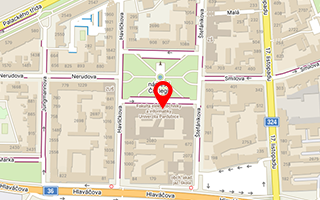Localization of a mobile robot in the mapped area
Supervisor: Ing. Petr Doležel, Ph.D.
The thesis is focused on the demonstration of robot's localization in mapped terrain using the method of Particle Filtering. Robot is constructed of LEGO Mindstorms Education kit and is able to determine its position when is placed into mapped field. In the first part of the thesis, there are described the techniques of positioning which are used for the localization in mobile robotics. The second part describes the construction plan of the robot and robot control. The robot is then used for the localization using Particle Filtering.
Solving of multicriterial cutting stock problem using evolutionary computation methods
Supervisor: Ing. Petr Doležel, Ph.D.
This diploma thesis deals with the usability of genetic algorithms for 2D non-guillotineable Log Cutting Problem (ngLCP) in wood industry. Two novel approaches for construction heuristics of solutions to ngLCP are presented and thoroughly tested. Novel fitness function for evaluation of cutting patterns is presented which aims to help evolution process in finding the right solution for ngLCP. Because of lack of literature about Lumber Cutting Problem or similar problem and resulting lack of testing scenarios, we propose new set of 15 real and synthetic containers and 5 small item sets. These scenarios were later used to compare proposed solution methods between each other. The thesis also consider multicriterial optimization where alongside of utilization the lumber quality is also optimized.
Stabilization and control of inverted pendulum
Supervisor: Ing. Petr Doležel, Ph.D.
This thesis deals with stabilisation of inverted pendulum, physical appearance of which is realised as a robot built from LEGO Mindstorms Education and which balances on wheels powered by two motors. Fuzzy regulator applying principles of fuzzy logic, which generates action signal based on evaluation of current state, is used for stabilisation. In the introduction of the thesis the problematic of inverted pendulum, possible methods of measuring of necessary input data and a way of stabilization are analysed. Next part deals in detail with principle of stabilization of the robot by fuzzy regulator, from structures of linguistic variables to the control algorithm itself. A description of the practical part follows from setting the computer environment variables and developing environment to controlling generated program part. In the conclusion of the thesis, the results of fuzzy control are evaluated.
Microprocessor control unit of double rotors laboratory system
Supervisor: Ing. Libor Havlíček, Ph.D.
This master's thesis deals with the design of hardware and software microprocessor control unit for two-rotor laboratory system. The control unit allows complete control of the controlled system, processing signals from position optical sensors and tachogenerators for use with the control unit, or for use in superior system - PC. Source codes for microprocessors are written in the programming language C. As a development environment is used AVR Studio 4.
Test platfrom of inertial navigation
Supervisor: Ing. Libor Havlíček, Ph.D.
This thesis describes the design and implementation of a test platform for inertial navigation. The second and third part is devoted to a theoretical analysis and kinematic structures. The third part describes the design and implementation of the actual construction solution. The hardware design of the system is described in the fourth part. Development of the control system, its setup and system control is shown in the fifth part. The thesis also presents practical verification of the function of the proposed device. In conclusion, results of the evaluation and experience with the proposed system are evaluated.
Predictive control of laboratory model
Supervisor: Ing. Daniel Honc, Ph.D.
Theory of mathematical and physical modeling, dynamic system identification and predictive control is briefly described in the thesis. Nonlinear model of laboratory system GUNT RT 010 is created in the experimental part and consequently identified. Furthermore, linearized model is created. The nonlinear model is verified with the real system and the also compared with linearized model. The main aim of this work is to design predictive controller (state-space and input-output one), to simulate control responses with the nonlinear model and to compare them with the real control experiments.
State-space control of laboratory system
Supervisor: Ing. Daniel Honc, Ph.D.
Master thesis deals with state-space control of laboratory system. Nonlinear model of the controlled process will be created, identified and linearized afterwards. Discrete-time and continuous-time state-space controller using pole placement method and discrete-time quadratic criterion will be designed. Simulations and real experiments will be compared for various controller settings.
Control of system engine - generator by multifunctional industrial controller KS 98-1
Supervisor: Ing. Libor Kupka, Ph.D.
The thesis is focused on the realization of control of real motor - generator system by an industrial controller KS 98 - 1. At first there is a description of main features, programming principles of the industrial controller and the most used control algorithms in the theoretical part. A process of realization of speed control of motor - generator including evaluation of the measured results is described in the practical part. To illustrate additional features of industrial controller and its algorithms is besides the speed control of motor - generator system does realization of control of outlet temperature of a water heater as well.

